Prehistoric-looking plecostomus are some of the most popular options for large freshwater tanks, but what if you only have a small to medium-sized set-up? If you’re looking for a dwarf algae eater suitable for tanks as small as 20-gallons, then check out our detailed Care Guide for the small and colorfully striped Clown Pleco!
Overview of the Clown Plecostomus
Scientific Name
Panaqolus Maccus
Common Name (species)
Clown Plecostomus, Clown Panaque, Ringlet Pleco (Panaqolus maccus)
Family
Loricariidae
Origin
Apuré and Caroní River Basins in Venezuela
Diet
Omnivore, but primarily feeds on driftwood, biofilm and algae
Feeding
Offer plenty of driftwood. Feed daily meals of sinking algae wafers, spirulina pellets and blanched veggies with weekly protein treats
Care Level
Easy
Activity
Nocturnal; most active at night or under low-light/shaded conditions
Temperament
Peaceful, shy and mellow; male fish can be territorial and may squabble over space in small aquariums
Tank Level
Bottom Dweller
Minimum Tank Size
20 gallons; allow 10 gallons per female and 20 per male
Temperature Range
73 to 82°F
Water Hardness
10 dGH, but tolerates seasonal variations/hard and soft water
pH Range
6.8 to 7.6
Filtration/Flow Rate
Well filtered water with a moderate rate of flow
Breeding
Egglayer; male fish protects the eggs in caves until they hatch
Compatible Tank Mates
Ideal for keeping with small tetras, minnows, rasboras, blue rams, South American cichlids or in a driftwood tank with other Loricariidae catfish
OK, for Planted Tanks?
Yes, but they may snack on the vegetation, so provide a mix of fast and slow-growing plants and supplement diet with blanched veggies and plenty of driftwood
There’s a plethora of small algae-eating fish suitable for nano set-ups, but you’re a lot more limited when it comes to keeping plecostomus in a small aquarium. Luckily, one of the most colorful plecos in the trade is also a peaceful dwarf species, so consider adding a striped Clown Pleco to your next aquatic community!

The Clown Pleco or Panaque (Spanish for “pleco”) has become a hugely popular option for community tanks over the last 20 years. They are easy to care for, relatively easy to breed and do well in tanks 20-gallons and up. Let’s take a look at the care requirements for the vivid black-and-yellow patterned Clown Panaque!
Natural History and Habitat
The Clown Pleco (Panaqolus maccus) is a newer member of the armored catfish or Loricariidae family. Native to tropical Venezuela, these fish were first described in 1993, but with their peaceful temperament and beautiful markings they quickly became a favorite in the aquarium trade:

- Populations of Clown Panaque are found along the Caroní and Apuré river basins in the heavily forested regions of Venezuela:
- They live on the bottoms of waterways in shallow streams densely packed with driftwood, sticks and rocks .
- They feed mostly on wood, algae and plant materials, but they’ll also eat insects, larvae and fry, especially in preparation for mating.
- These fish are nocturnal and spend the daylight hours hiding in caves and under the piles of driftwood, and do most of their scavenging at night.
- Wild Clowns naturally experience and tolerate a wide range of seasonal variations in their water parameters, since the wintertime weather is dry and cool until the start of the warmer rainy season.
- Changes in the temperature, pH and water hardness signal the beginning of the spring breeding season.
Types of Clown Plecos and Their L-Numbers
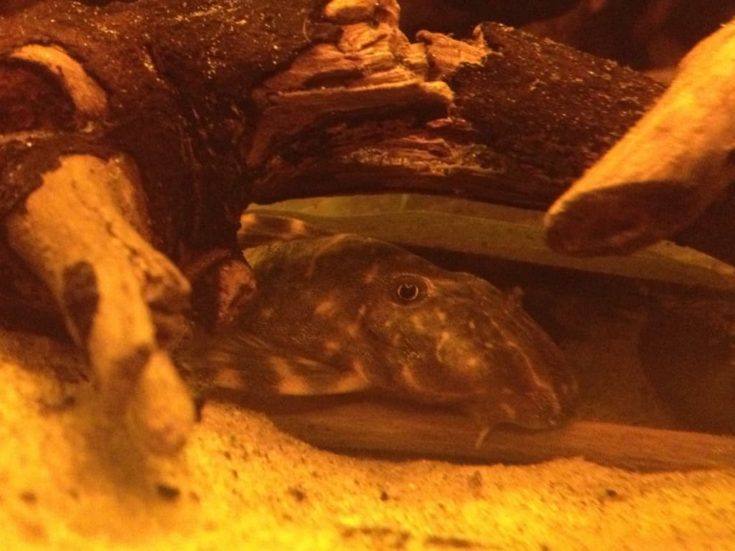
Clown Plecos have only been identified in the last 30 years, so we’re still in the early stages when it comes to describing them scientifically. This creates a problem for aquatic shops and hobbyists, though: How can we distinguish between multiple species when they share the same scientific and common name?
While the Clown Pleco is currently classified as “Panaqolus maccus,” aquarists believe there are at least two distinct species (with different size ranges) and several unrelated mimics with similar ranges and appearances. How can you know which type of dwarf or Clown Pleco you’re buying if you’re not an expert?
Pleco collectors, breeders and sellers utilize a special code called an “L-Number” to identify varieties of catfish apart from their generic species or common names. I’m not going to bore you with details, but the L-Number is a useful tool for ensuring you get the correct species and don’t end up with a fish that outgrows your tank.
Clown Pleco
Scientific Name
Panaqolus maccus
L-Number(s)
L104, L162
Average Length
3.5 inches
Clown Pleco
Scientific Name
Panaqolus sp.
L-Number(s)
L448
Average Length
4.3 inches
Clown Pleco
Scientific Name
Panaqolus sp.
L-Number(s)
L206
Average Length
3.1 inches
Mega Clown Pleco
Scientific Name
Hypancistrus sp.
L-Number(s)
L340
Average Length
3.1 inches
Candy Stripe Pleco
Scientific Name
Peckoltia vittata
L-Number(s)
L015
Average Length
5.5 inches
Clown Panaque Size and Appearance
Clowns plecos are usually sold as 2-inch juveniles and range from 3 to 4 inches in length at maturity, although at least one variety (L448) regularly tops 4-inches from snout to tail. Most varieties of Clown average about 3.5-inches and are suitable for smaller aquarium communities.
Clowns have the standard pleco shape with a wide head that angles into a flat, narrow body with a laterally facing suckermouth, broad pectoral and abdominal fins and a tall, upright rayed dorsal fin.
Their outstanding traits, however, are their vibrant colors and distinctive markings! Clown plecos have a dark brown to black base color overlaid by bright bands or stripes that vary from white to a vivid orange/yellow:
- Young fish and those kept in outdoor ponds are usually the brightest colored, and these markings tend to change and fade as the fish age.
- Their habitat, diet and water quality also influence their appearance, and plecos tend to lose color when they are stressed or ill.
Clown Pleco Male vs Female
It’s not always easy for novices to identify male and female fish outside the breeding season, but if you look closely you should be able to distinguish their genders once your fish is about a year old:
- Female Clown plecos are usually larger, and they look very plump and round when viewed from above as they get ready to produce eggs.
- Male Clown plecos have a leaner, shorter body and have tiny spines called odontodes along their gill covers and caudal fins.
Clown Pleco Mimic Species
There are two species of catfish that look very similar to the Clown Pleco and are often mislabeled as Clowns in pet stores. But these species have different size ranges and care requirements, so don’t get them by mistake! Using the L-Numbers provided above, you can be sure you buy the right pleco for your tank:
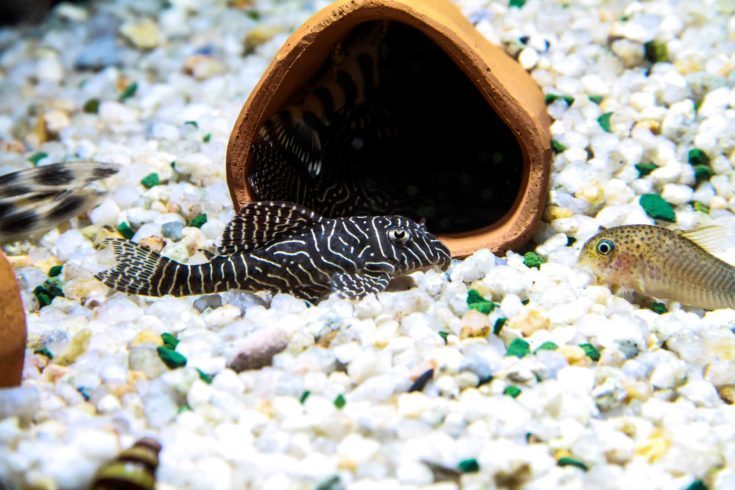
- The Mega Clown or Imperial Tiger Pleco (Hypancistrus sp.) stays around 3-inches in length but is a much less-effective algae eater than the true Clown Pleco, and they’re not a big fan of consuming driftwood. They need a higher amount of protein in their diets as well
- The Candy Striped Pleco (Peckoltia vittata) closely resembles the Clown in terms of their markings, but they grow up to 5.5 inches in length and can be territorial and aggressive with other bottom dwellers
Lifespan
Clown plecos can survive for about 10 to 12 years in an aquarium, but the quality of their care has a direct impact on their lifespan. Poor water quality and an improper diet will dramatically shorten their longevity in captivity.
Behavior and Temperament
Clown Panaque are mostly nocturnal and active at night, although you can train your algae eaters with food to come out in the shaded areas of your tank during the day. They are peaceful, mellow and rather shy fish, who prefer to hide from the bright lights and activity in caves of driftwood.
While they are not aggressive, male fish may be territorial with each other, so be sure you have enough room if you’re keeping a group. As catfish, Clowns may opportunistically eat small invertebrates and fry, but they won’t actively hunt your fish community.
How to Care for Your Clown Plecostomus
Clown plecos are easy to care for and very undemanding aquatic pets as long as their few key requirements are met. The most important features of a Clown Panaque tank are a robust filtration system and plenty of driftwood and bogwood decor!
Clown Pleco Tank and Habitat Requirements
Let’s take a look at the ideal tank set-up for these colorful dwarf catfish!
Aquarium Size

For a single Clown pleco, you’ll need at least a 20-gallon tank, but bigger is always better if you can swing it. If you have the option, buy a standard Long or Breeder tank rather than a High style, since they provide more room for bottom-dwelling fish. If you’d like to keep a group of Clown plecos you’ll just need a bigger tank!
I like to allow 20 gallons of capacity for every male and an additional 10-gallons for every female. So for a community tank with a group of four Clown plecos (3 female/1 male), you’d need a 50-gallon aquarium!
Substrate
Since Clown plecos are bottom dwellers who dig caves for spawning and hiding, it’s best to use a soft substrate that won’t injure their fins or abdomens. Many aquarists go with bare-bottomed set-ups for breeding, but using aquatic soil, sand or fine gravel is ideal for community tanks, especially if you’re growing live plants too.
Water and Temperature Parameters
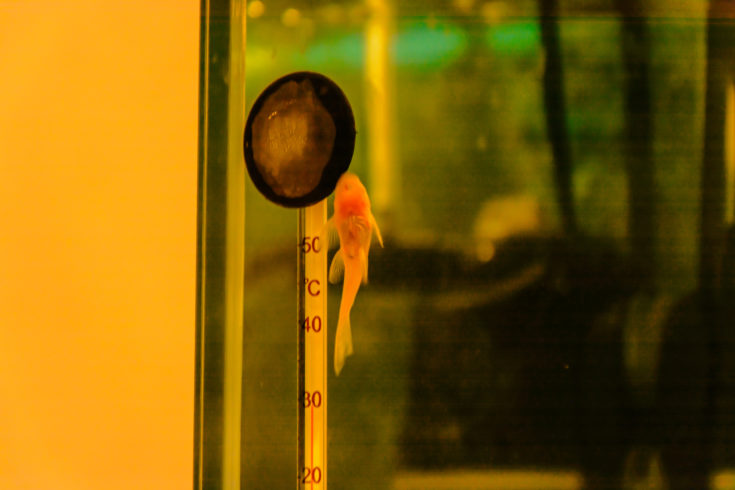
Clown catfish prefer their water on the warmer side from 73 to 83°F. Using a heater makes it easier to mimic season variations and raise and lower the temperatures if you’d like your fish to spawn. Their ideal pH range is from 6.8 to 7.6, and they tolerate both hard and soft water conditions (see Breeding below).
Filtration and Aeration
Clown Panaque, like most catfish species, are eating machines and produce a lot of waste for their size. Since they primarily consume fibrous materials, they require a robust filtration system with replaceable media that both mechanically and chemically removes waste and toxins from the water.
Clowns prefer a moderate rate of water flowing along the bottom of their tank, which helps prevent dangerous hypoxic areas from developing. You can use either a canister or HOB filter for your pleco tank, and it never hurts to use an air stone to improve the circulation.
Lighting, Plants and Decorations
As nocturnal fish, Clown plecos don’t appreciate bright lights and will usually hide in caves or under rocks during the day unless the tank is shaded by floating plants or decor. They often snack on plants but are usually not destructive, so it’s best to provide a mix of fast and slow-growing options in your tank.
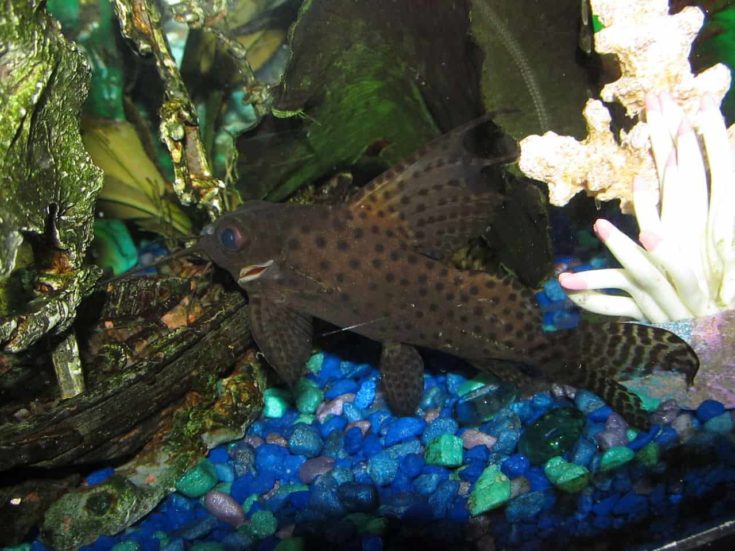
In terms of decor, these fish need a lot of driftwood, bogwood, sticks and branches to be happy. They feed heavily on wood products, so providing them with a variety of options helps balance their diet. Adding rocks also helps encourage the development of edible algae and biofilm for your plecos.
Maintenance
Since catfish produce so much waste, it’s important to perform regular water changes on your Clown pleco tank to prevent a build-up of toxins in your water. Smaller aquariums may require weekly water changes, and doing a large-volume change is a great way to encourage spawning!
Feeding
Like most catfish, Clown plecos are scavenging omnivores, and while they mostly consume driftwood, algae and biofilm, they will readily eat live and protein-rich foods, especially when preparing to breed. Since aquariums just can’t provide fish with a naturally balanced and healthy diet, you’ll have to offer supplements.
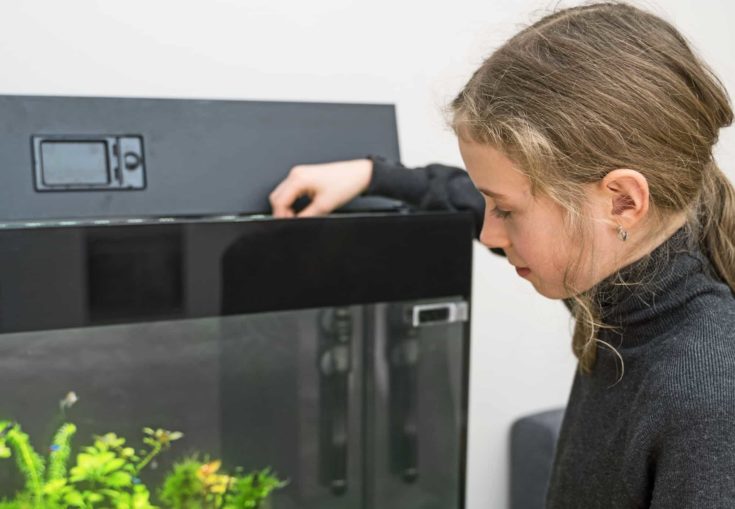
It’s best to feed your Clown plecos every day right around dusk or shortly after your lights switch off for the night:
- Offer them a rotating mix of sinking algae wafers and spirulina pellets.
- To deter them from eating your live plants, you can give them freshly blanched veggies like peas, carrots, cucumbers and spinach.
- Offer live treats of brine shrimp, bloodworms or Daphnia eggs 1 to 2 times a week (or daily in the weeks leading up to spawning).
Tank Mates
The best tank mates to keep with Clown Pleco just depend on the size of your community. Some of the best options include peaceful, mid-level fish like tetras, rasboras and minnows, but Clowns also do well with other bottom dwellers like loaches and Corydoras species.
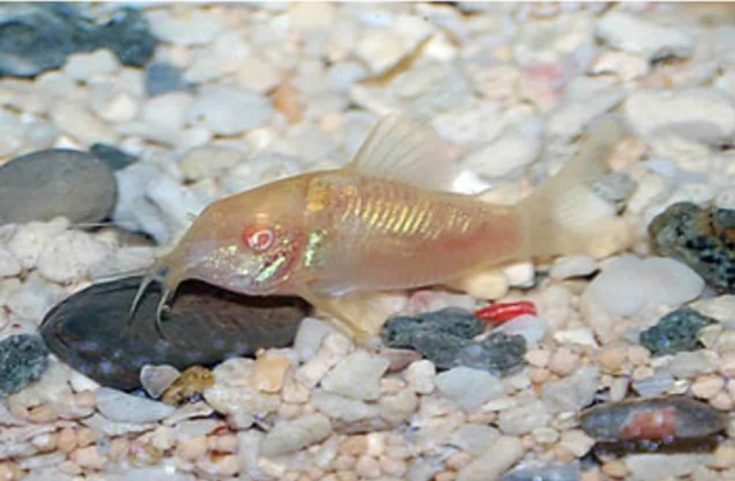
You could also keep them in South American-themed tanks with German Blue Rams or non-aggressive cichlids. Or fill your tank with driftwood and just keep a mixed variety of Clown, Candy Stripe and Bristlenose Plecos!
Breeding
Clowns are one of the few species of pleco known to breed spontaneously in captivity when kept in mixed-gender groups. Their breeding requirements are similar to the Bristlenose pleco, with the male Clown providing protection and care for the eggs until the fry hatch. Female fish and rival males will eat these eggs if they can!
If you provide plenty of PVC or driftwood caves and alter your water parameters to mimic the spring rainy season, you may soon find your male fish guarding eggs! To prepare your Clown community for spawning:
- Slowly increase your water temperature to 85°F over a two week period while feeding a protein-rich diet.
- Do a large water change, adding back very cool, soft water around 70°F.
- Within a few days, you should observe your male jealousy standing guard over the eggs attached to the inside of his cave!
You can set-up a breeding tank for your catfish, or you can let them spawn inside your community tank and move the egg-laden cave to a safer set-up prior to hatching. While the male will prevent other fish from eating the eggs, if you want to keep the fry safe from community predators you’ll need a tank to raise them in.
Health Concerns
Clown catfish are susceptible to the same common aquatic diseases as other fish (like White Spot or Ich), but they are generally a very healthy and hardy species if their water is kept clean and they’re offered a balanced diet. If you quarantine new fish and plants before adding them to your tank you’ll avoid a lot of problems.
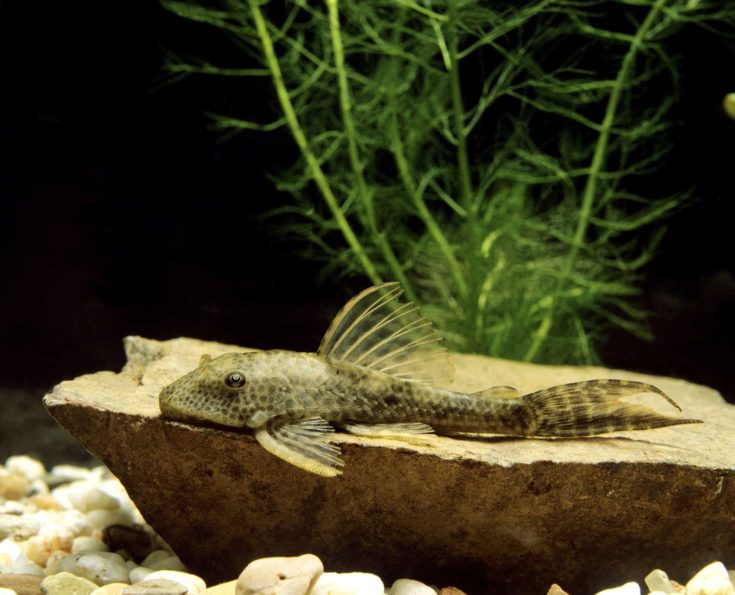
The biggest mistake I’ve seen folks make with Clown catfish is not providing them with enough edible driftwood decor to snack on. If these fish don’t get enough fiber in their diet, their gut bacteria can get out of whack and cause digestive problems. A Clown pleco can starve to death if their diet is deprived of driftwood for too long.
How to Set-Up a Clown Pleco Tank: Equipment and Supply List
To set up a planted community tank with a single Clown pleco and a small school of community fish, you’ll need:
- 20 Gallon or larger Long-style aquarium with cover/lid
- HOB or Canister Filtration System
- Aquarium Heater
- Aquatic soil, sand or fine gravel substrate
- Decor made from driftwood, bogwood, sticks and branches
- Live Plants, rocks and other decorations
- Water conditioner
To feed your Clown Pleco, you’ll need:
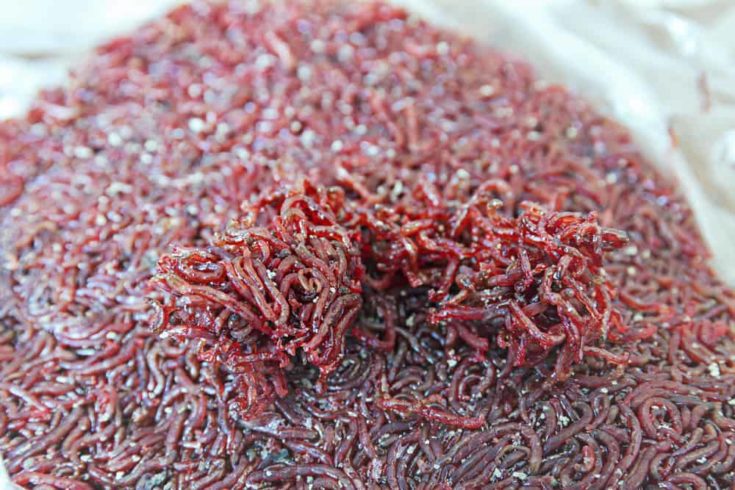
- Sinking algae wafers
- Spirulina pellets
- Blanched veggies
- Live/frozen/dried brine shrimp, bloodworms or Daphnia eggs
Optional equipment includes:
- Airstone and pump
- Aquarium lights and/or Moonlight for nighttime viewing
- Second tank and sponge filter for raising fry
Conclusion
Does the Clown Pleco sound like a fun option for your next planted tank? We’d love to hear your opinions in the comments, or join our larger community of fish keepers on social media. Show us your pleco tank and tell us all about your favorite species of catfish!